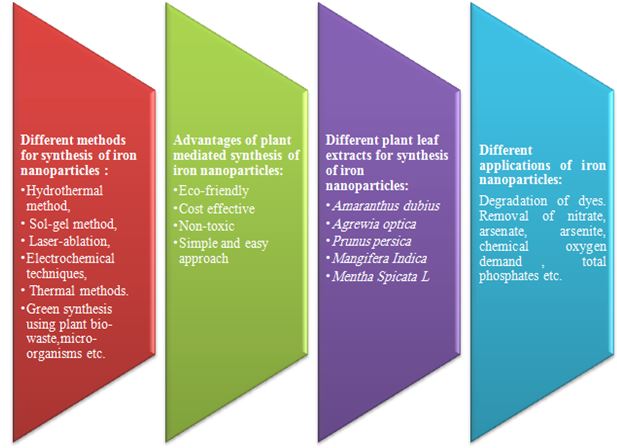References:
[1] K.M.A. El-Nour, A.a. Eftaiha, A. Al-Warthan and R.A. Ammar, Synthesis and applications of silver nanoparticles. Arabian journal of chemistry, 3 (2010) 135-140.
[2] I. Khan, K. Saeed and I. Khan, Nanoparticles: Properties, applications and toxicities. Arabian Journal of Chemistry, (2017)
[3] B. Khodashenas and H.R. Ghorbani, Synthesis of silver nanoparticles with different shapes. Arabian Journal of Chemistry, (2015)
[4] G. Sharma, A. Kumar, S. Sharma, M. Naushad, R.P. Dwivedi, Z.A. ALOthman and G.T. Mola, Novel development of nanoparticles to bimetallic nanoparticles and their composites: a review. Journal of King Saud University-Science, (2017)
[5] A.U. Mirza, A. Kareem, S.A. Nami, M.S. Khan, S. Rehman, S.A. Bhat, A. Mohammad and N. Nishat, Biogenic synthesis of iron oxide nanoparticles using Agrewia optiva and Prunus persica phyto species: characterization, antibacterial and antioxidant activity. Journal of Photochemistry and Photobiology B: Biology, 185 (2018) 262-274.
[6] A.B. Seabra, P. Haddad and N. Duran, Biogenic synthesis of nanostructured iron compounds: applications and perspectives. IET nanobiotechnology, 7 (2013) 90-99.
[7] M. Harshiny, C.N. Iswarya and M. Matheswaran, Biogenic synthesis of iron nanoparticles using Amaranthus dubius leaf extract as a reducing agent. Powder technology, 286 (2015) 744-749.
[8] M.J. Firdhouse and P. Lalitha, Biosynthesis of silver nanoparticles and its applications. Journal of Nanotechnology, 2015 (2015)
[9] J. Conde, G. Doria and P. Baptista, Noble metal nanoparticles applications in cancer. Journal of drug delivery, 2012 (2012)
[10] C. Devatha, K. Jagadeesh and M. Patil, Effect of green synthesized iron nanoparticles by Azardirachta indica in different proportions on antibacterial activity. Environmental Nanotechnology, Monitoring & Management, 9 (2018) 85-94.
[11] S. Groiss, R. Selvaraj, T. Varadavenkatesan and R. Vinayagam, Structural characterization, antibacterial and catalytic effect of iron oxide nanoparticles synthesised using the leaf extract of Cynometra ramiflora. Journal of Molecular Structure, 1128 (2017) 572-578.
[12] S. Bishnoi, A. Kumar and R. Selvaraj, Facile synthesis of magnetic iron oxide nanoparticles using inedible Cynometra ramiflora fruit extract waste and their photocatalytic degradation of methylene blue dye. Materials Research Bulletin, 97 (2018) 121-127.
[13] G. Jagathesan and P. Rajiv, Biosynthesis and characterization of iron oxide nanoparticles using Eichhornia crassipes leaf extract and assessing their antibacterial activity. Biocatalysis and agricultural biotechnology, 13 (2018) 90-94.
[14] G.E. Hoag, J.B. Collins, J.L. Holcomb, J.R. Hoag, M.N. Nadagouda and R.S. Varma, Degradation of bromothymol blue by ‘greener’nano-scale zero-valent iron synthesized using tea polyphenols. Journal of Materials Chemistry, 19 (2009) 8671-8677.
[15] Z.R. Zad, S.S.H. Davarani, A.R. Taheri and Y. Bide, Highly selective determination of amitriptyline using Nafion-AuNPs@ branched polyethyleneimine-derived carbon hollow spheres in pharmaceutical drugs and biological fluids. Biosensors and Bioelectronics, 86 (2016) 616-622.
[16] T. Wang, J. Lin, Z. Chen, M. Megharaj and R. Naidu, Green synthesized iron nanoparticles by green tea and eucalyptus leaves extracts used for removal of nitrate in aqueous solution. Journal of Cleaner Production, 83 (2014) 413-419.
[17] S.S. Poguberović, D.M. Krčmar, S.P. Maletić, Z. Kónya, D.D.T. Pilipović, D.V. Kerkez and S.D. Rončević, Removal of As (III) and Cr (VI) from aqueous solutions using “green” zero-valent iron nanoparticles produced by oak, mulberry and cherry leaf extracts. Ecological engineering, 90 (2016) 42-49.
[18] C. Devatha, A.K. Thalla and S.Y. Katte, Green synthesis of iron nanoparticles using different leaf extracts for treatment of domestic waste water. Journal of cleaner production, 139 (2016) 1425-1435.
[19] Y. Wei, Z. Fang, L. Zheng, L. Tan and E.P. Tsang, Green synthesis of Fe nanoparticles using Citrus maxima peels aqueous extracts. Materials Letters, 185 (2016) 384-386.
[20] K.S. Prasad, P. Gandhi and K. Selvaraj, Synthesis of green nano iron particles (GnIP) and their application in adsorptive removal of As (III) and As (V) from aqueous solution. Applied Surface Science, 317 (2014) 1052-1059.
[21] Z. Wang, C. Fang and M. Megharaj, Characterization of iron–polyphenol nanoparticles synthesized by three plant extracts and their fenton oxidation of azo dye. ACS Sustainable Chemistry & Engineering, 2 (2014) 1022-1025.
[22] Y. Kuang, Q. Wang, Z. Chen, M. Megharaj and R. Naidu, Heterogeneous Fenton-like oxidation of monochlorobenzene using green synthesis of iron nanoparticles. Journal of colloid and interface science, 410 (2013) 67-73.
[23] M. Mahdavi, F. Namvar, M. Ahmad and R. Mohamad, Green biosynthesis and characterization of magnetic iron oxide (Fe3O4) nanoparticles using seaweed (Sargassum muticum) aqueous extract. Molecules, 18 (2013) 5954-5964.
[24] T. Shahwan, S.A. Sirriah, M. Nairat, E. Boyacı, A.E. Eroğlu, T.B. Scott and K.R. Hallam, Green synthesis of iron nanoparticles and their application as a Fenton-like catalyst for the degradation of aqueous cationic and anionic dyes. Chemical Engineering Journal, 172 (2011) 258-266.
[25] T. Wang, X. Jin, Z. Chen, M. Megharaj and R. Naidu, Green synthesis of Fe nanoparticles using eucalyptus leaf extracts for treatment of eutrophic wastewater. Science of the total environment, 466 (2014) 210-213.
[26] S. Branch, A sensor for determination of tramadol in pharmaceutical preparations and biological fluids based on multi-walled carbon nanotubes-modified glassy carbon electrode. J. Chem. Soc. Pak, 35 (2013) 1106.
[27] S. Venkateswarlu, Y.S. Rao, T. Balaji, B. Prathima and N. Jyothi, Biogenic synthesis of Fe3O4 magnetic nanoparticles using plantain peel extract. Materials Letters, 100 (2013) 241-244.
[28] A. Rao, A. Bankar, A.R. Kumar, S. Gosavi and S. Zinjarde, Removal of hexavalent chromium ions by Yarrowia lipolytica cells modified with phyto-inspired Fe0/Fe3O4 nanoparticles. Journal of contaminant hydrology, 146 (2013) 63-73.
[29] V. Smuleac, R. Varma, S. Sikdar and D. Bhattacharyya, Green synthesis of Fe and Fe/Pd bimetallic nanoparticles in membranes for reductive degradation of chlorinated organics. Journal of membrane science, 379 (2011) 131-137.


